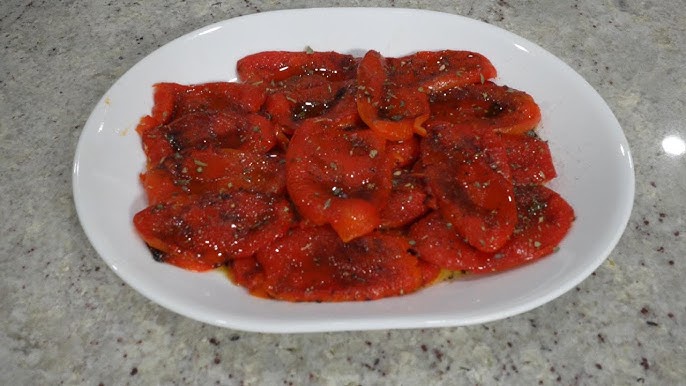Roasted Red Peppers Recipe: Roasted red peppers are one of those simple culinary delights that manage to bring big flavor with minimal effort. Whether you’re a home cook looking to elevate your dishes or just someone who loves bold flavors, roasted red peppers are a must-have in your kitchen arsenal. Their naturally sweet, smoky, and slightly tangy taste adds depth to nearly any dish—from hearty pasta sauces and vibrant salads to creamy dips and savory sandwiches.
Unlike store-bought varieties that often contain preservatives, homemade roasted red peppers taste fresher, and you can control the level of char, seasoning, and texture. You’ll also be surprised at how easy it is to roast them yourself. No fancy skills needed—just a few fresh peppers, a heat source, and a bit of patience.
Roasting brings out the natural sugars in the pepper, caramelizing the skin and giving it that signature smoky flavor. Once charred, the skin peels off easily, leaving soft, juicy flesh that you can marinate, puree, or eat as-is.
In this guide, we’ll break down everything you need to know about making perfect roasted red peppers at home—from selecting the right peppers and choosing the best roasting method to peeling, storing, and using them in everyday meals.
Let’s dive into the delicious world of roasted red peppers and see why this humble veggie deserves a permanent spot in your fridge (and on your plate).
Why Roasted Red Peppers Are a Kitchen Staple
There’s a good reason roasted red peppers are beloved across global cuisines—they’re incredibly versatile. You can blend them into sauces, toss them on pizzas, layer them in sandwiches, or just enjoy them straight out of the jar with a splash of olive oil and herbs.
They also serve as an excellent base for spreads like Muhammara (a Middle Eastern dip made with walnuts and breadcrumbs) or roasted red pepper hummus. You can fold them into pasta dishes for a creamy, colorful sauce or stuff them into omelets for a burst of flavor.
Beyond their use in fancy dishes, roasted red peppers are great for meal prepping. Roast a batch at the start of the week, and you’ll have a flavorful ingredient ready to go for breakfasts, lunches, and dinners.
If you’re into health-conscious cooking, these peppers are a win—they’re low in calories, high in vitamin C, and packed with antioxidants. And unlike frying or heavy sauces, roasting is a light cooking method that enhances natural flavor without adding extra fat.
In short, roasted red peppers are the unsung hero of the kitchen—easy to make, endlessly usable, and oh-so-delicious.
Nutritional Benefits of Roasted Red Peppers
You might think something this tasty can’t possibly be healthy—but roasted red peppers are actually a nutritional powerhouse. One medium red bell pepper packs more than 150% of your daily recommended vitamin C intake. That’s more than an orange!
They’re also rich in vitamin A (for healthy vision), vitamin B6 (for brain health), and folate (especially important for pregnant women). Add to that a solid dose of antioxidants like beta-carotene and lutein, and you’ve got a vegetable that’s just as good for your body as it is for your taste buds.
And get this—they’re super low in calories. One medium red pepper has just 30–40 calories. Roasting them doesn’t add much unless you go heavy on the oil.
Their high fiber content supports digestion and helps you feel full, making them great for weight loss or maintaining a healthy lifestyle. Plus, they’re naturally sweet, which makes them a smart alternative to sugary snacks or sauces.
All in all, roasted red peppers are a guilt-free way to add color, flavor, and health benefits to your meals.
Ingredients You’ll Need
Creating delicious roasted red peppers starts with a short and sweet list of ingredients. You don’t need a packed pantry—just a few quality items that make all the difference in flavor and texture.
Fresh Ingredients List:
- Red Bell Peppers (4–6 large, firm, and shiny)
- Olive Oil (extra virgin preferred)
- Kosher Salt (or sea salt)
- Fresh Garlic (optional, for storage or flavor infusion)
- Fresh Herbs (optional—like parsley, thyme, or basil)
Optional Add-ons for Enhanced Flavor:
- Balsamic Vinegar (for a tangy finish)
- Cracked Black Pepper
- Lemon Juice
- Chili Flakes (for a little heat)
Recommended Kitchen Tools:
- Baking sheet or grill pan
- Tongs
- Parchment paper or aluminum foil
- A large bowl with lid or plastic wrap (for steaming)
- Airtight glass jars or containers (for storage)
The beauty of this recipe lies in its simplicity. Start with high-quality peppers, and you’re already halfway to a delicious dish. As you gain confidence, feel free to experiment with the optional ingredients to suit your personal flavor profile.
Preparing the Peppers
Before the peppers hit the heat, there’s a bit of prep work to ensure they roast evenly and come out perfect every time. First, pick out peppers that are heavy, firm, and glossy. The skin should be unblemished and tight with no wrinkling or soft spots. The brighter the red, the sweeter and more flavorful they’ll be after roasting.
Once you’ve selected your peppers, rinse them thoroughly under cool water to remove any dirt or residue. Dry them completely with a paper towel or clean kitchen cloth—excess moisture can steam the peppers instead of roasting them, which affects the final texture and flavor.
You don’t need to slice or core the peppers before roasting, especially if you’re using the oven or grill. Keeping them whole helps retain their juices and prevents them from drying out. If you prefer faster cooking or plan to pan-sear them, you can slice them in halves or quarters and remove the seeds beforehand.
At this stage, you can also lightly coat them with olive oil if you like a softer roast. Otherwise, roasting them dry works perfectly fine and lets the natural sweetness come through more prominently.
Next up, let’s explore the different ways to roast these vibrant veggies—each method gives a slightly different flavor and texture.
Roasting Methods – Choose Your Style
Roasting red peppers might seem straightforward, but there’s more than one way to do it—each method offering its own twist on flavor and texture. Depending on what tools you have at home, you can roast them in the oven, on a gas stove, under a broiler, or even on the grill. Let’s break down each technique so you can choose what works best for your kitchen setup and taste preferences.
Oven Roasting Method
Oven roasting is one of the most popular and convenient methods, especially if you’re roasting a big batch. It’s clean, hands-off, and delivers perfectly charred skins with soft, sweet interiors.
How to do it:
- Preheat your oven to 450°F (230°C).
- Line a baking sheet with parchment paper or aluminum foil for easy cleanup.
- Place whole red peppers directly on the sheet—no oil necessary, though a light coating can help if you prefer.
- Roast for 25–30 minutes, turning them every 7–10 minutes to ensure even charring.
- The skin should blacken and blister while the flesh becomes tender.
This method gives you consistent results and is great when you want roasted peppers with an evenly smoky taste.
Gas Stove Roasting Method
If you love that deep, authentic smoky flavor, roasting over an open gas flame is the way to go. This method is quick, but it requires close attention and a bit of hands-on work.
Steps:
- Turn on your gas burner to medium-high.
- Using tongs, place the pepper directly over the flame.
- Rotate frequently until the entire skin is blackened and blistered.
- This usually takes 10–12 minutes per pepper.
Be sure to ventilate your kitchen, as the smoky aroma can get intense. This technique produces a bold, charred flavor that’s restaurant-quality.
Grill Roasting Method
Grilling red peppers not only gives them a smoky flavor but also allows you to roast large quantities during BBQ sessions or cookouts.
Instructions:
- Preheat your grill to high.
- Place whole peppers directly on the grates.
- Turn every few minutes until all sides are charred.
- Total grilling time: about 15–20 minutes.
This method imparts a unique, fire-grilled flavor that’s unbeatable in summer dishes or smoky dips.
Broiler Method (Quickest Way)
Short on time? The broiler method is your go-to. It mimics the high heat of a grill and gives you roasted perfection in under 10 minutes.
Steps:
- Move your oven rack to the top (about 6 inches from the broiler).
- Turn your broiler on high.
- Place whole or halved peppers skin-side up on a broiler-safe tray.
- Broil for 5–10 minutes, watching closely to avoid burning.
This method is fast and efficient, making it ideal for weeknight meals or quick appetizers.
Step-by-Step Guide to Roasting Red Peppers
Now that you know the different methods, it’s time to dive into the actual roasting process step by step. Whether you’re a beginner or a seasoned cook, following this easy guide will help you master the art of making tender, flavorful roasted red peppers every time.
Step 1 – Preheat and Prepare
Start by choosing your roasting method (oven, grill, broiler, or stovetop). If using the oven, preheat it to 450°F (230°C). Prepare your workspace by lining a baking tray or having your tongs and gas burner ready.
While the heat source warms up, wash your peppers thoroughly. Pat them completely dry. Optionally, brush them with a little olive oil for an extra layer of richness and softness. You can roast them whole or halved—just know that whole peppers retain more moisture and sweetness.
Place the peppers on the chosen roasting surface. If roasting in an oven or grill, make sure they have room and aren’t overcrowded.
Step 2 – Roast to Perfection
Begin roasting your peppers using your preferred method. If oven-roasting, flip every 7–10 minutes to ensure even blackening. Grill and gas stove methods require more frequent turning—about every 2–3 minutes.
You’ll know your peppers are done when:
- The skin is charred and bubbly across the surface.
- The peppers have collapsed slightly.
- They emit a smoky-sweet aroma.
This usually takes:
- Oven: 25–30 minutes
- Grill: 15–20 minutes
- Broiler: 5–10 minutes
- Gas flame: 10–12 minutes
Once roasted, immediately transfer the peppers into a large bowl and cover tightly with a lid, plate, or plastic wrap. This creates steam that loosens the skins, making them super easy to peel.
Step 3 – Steam and Peel the Skins
Let the roasted peppers sit covered for 10–15 minutes. During this time, the residual heat and steam soften the skin and separate it from the flesh. Once cool enough to handle, begin peeling.
Use your fingers or a paper towel to gently rub the skins off. Avoid rinsing under water—it removes the flavorful oils that give roasted peppers their character. You want to keep all that roasted essence intact.
Remove the stems, seeds, and membranes. If you roasted them whole, just slice them open and clean out the insides. Don’t worry about a few stubborn bits of skin—perfection isn’t necessary.
Step 4 – Slice, Store, or Serve
Once peeled, slice the peppers into strips or pieces depending on how you plan to use them. Want to serve them immediately? Toss with a bit of olive oil, salt, garlic, and herbs for a beautiful appetizer or side.
If storing:
- Use airtight glass containers.
- Drizzle with olive oil and a pinch of salt.
- Add garlic or herbs for infused flavor.
They’ll stay fresh in the fridge for up to one week or longer if preserved correctly.
Storing and Preserving Roasted Red Peppers
Roasting a batch of red peppers is only part of the magic—knowing how to store and preserve them properly ensures you can enjoy that rich, smoky flavor for days or even months to come. Whether you’re making them for meal prep, future recipes, or homemade gifts, storing them right will keep them tasting just as delicious as the day you roasted them.
Refrigerator Storage Tips
If you’re planning to use your roasted red peppers within a week, the refrigerator is your best bet. After peeling and slicing, place them in an airtight glass container or mason jar. Drizzle with olive oil to coat and optionally toss in a clove of garlic or some herbs for extra flavor infusion.
Here’s a quick guide:
- Container: Use a clean, sealed container to avoid moisture and odor transfer.
- Oil: A light olive oil coating helps preserve texture and flavor.
- Add-ons: Garlic cloves, fresh herbs (like rosemary or basil), or even a splash of vinegar can elevate flavor while keeping bacteria at bay.
- Shelf life: Up to 7 days in the refrigerator.
Remember: always use a clean utensil to remove peppers from the jar to avoid contamination.
Freezing Roasted Red Peppers
Want to make your roasted red peppers last even longer? Freezing is an excellent option. It won’t affect the flavor, though the texture might soften slightly—perfect for sauces, soups, and blended dishes.
How to freeze roasted red peppers:
- After roasting, peeling, and slicing, allow the peppers to cool completely.
- Spread slices on a baking sheet in a single layer and freeze for 1–2 hours.
- Transfer the frozen slices into a zip-top freezer bag or airtight container.
- Label with the date and store in the freezer for up to 6 months.
When you’re ready to use them, just thaw in the refrigerator overnight or drop them directly into hot dishes like stews or pasta sauces.
Preserving in Oil or Vinegar
For longer-term storage without freezing, you can preserve roasted red peppers in oil or vinegar, turning them into a flavorful condiment that gets better with time.
Oil preservation tips:
- Layer peppers in a sterilized jar.
- Add aromatics like garlic, bay leaves, or peppercorns.
- Fill the jar with olive oil until fully submerged.
- Store in the fridge for up to 2–3 weeks.
Vinegar preservation:
- Use a mix of white vinegar and water (1:1 ratio) with a bit of salt and sugar.
- Bring to a boil, pour over peppers in sterilized jars, and seal.
- Store in a cool, dark place for up to 3 months (refrigerate once opened).
Always check for spoilage before consuming—if the oil looks cloudy or there’s any mold, toss it.
How to Use Roasted Red Peppers
Roasted red peppers are the culinary equivalent of a blank canvas—they can go in, on, or around just about anything. Once you’ve got them prepped and ready, it’s time to put them to work in your favorite recipes.
As a Side or Topping
Roasted red peppers shine as a simple side dish or flavorful topping. Here are some quick and easy ideas:
- Antipasto Platter: Pair with olives, cheese, artichoke hearts, and cured meats.
- Toast Topping: Layer with goat cheese or hummus for a colorful, savory snack.
- Grilled Meats: Use as a garnish for steak, chicken, or fish.
- Scrambled Eggs/Omelettes: Toss into morning eggs for a smoky twist.
Toss them in olive oil, add salt and fresh herbs, and you’ve got a restaurant-worthy addition to any meal.
In Soups, Sandwiches, and Salads
Roasted red peppers bring moisture, flavor, and visual appeal to everything from hearty sandwiches to crisp salads and creamy soups.
Try these:
- Roasted Red Pepper Soup: Blend with garlic, onion, and broth for a silky starter.
- Mediterranean Sandwich: Layer with feta, olives, arugula, and hummus in pita bread.
- Grain Bowls: Add sliced peppers to quinoa or rice bowls with chickpeas and tahini dressing.
- Pasta Salad: Dice and mix with cucumbers, olives, feta, and pasta for a bright, zesty salad.
Their naturally sweet flavor pairs beautifully with sharp cheeses, tangy vinaigrettes, and earthy grains.
Blending into Sauces or Spreads
Roasted red peppers are amazing when pureed into creamy sauces, spreads, or dips. Their soft texture and rich flavor make them ideal for blending.
Ideas to try:
- Roasted Red Pepper Hummus: Blend with chickpeas, tahini, garlic, lemon juice, and spices.
- Creamy Pasta Sauce: Mix with cream, garlic, and parmesan for a velvety red sauce.
- Muhammara: A Middle Eastern dip made with roasted peppers, walnuts, breadcrumbs, and spices.
- Pizza Sauce: Puree with tomato, basil, and garlic for a fresh twist on traditional pizza sauce.
These sauces can be stored in jars and used throughout the week to elevate just about any dish.
Tips for Perfect Roasted Red Peppers Every Time
Even the simplest recipes can go sideways without the right tips and tricks. Whether you’re roasting for the first time or the fiftieth, these pro pointers will help you get that perfect char, soft flesh, and deep flavor every single time.
Common Mistakes to Avoid
Avoid these pitfalls:
- Skipping the steam step: This makes the skin harder to peel and affects the texture.
- Using wrinkled or old peppers: Fresh, firm peppers roast better and taste sweeter.
- Overcrowding the tray: This causes uneven roasting and steaming instead of charring.
- Peeling under running water: This washes away those delicious natural oils and flavor.
- Not turning them often: Leads to uneven roasting and potential burning.
Small mistakes can mean big flavor losses, so follow the steps closely.
Flavor Enhancing Hacks
Want to level up your peppers? Try these:
- Brush with garlic oil before roasting for extra aroma.
- Sprinkle a pinch of smoked paprika post-roast to double down on smokiness.
- Add lemon zest or a splash of balsamic vinegar after slicing for a punchy finish.
- Roast with other vegetables like onions or tomatoes for a natural infusion of flavor.
You can also roast colored bell peppers (yellow, orange) for a mix of sweet flavors and a more colorful presentation.
FAQs about Roasted Red Peppers Recipe
1. Can I roast peppers in an air fryer?
Yes! Set your air fryer to 400°F (200°C) and roast whole or halved peppers for 15–20 minutes, turning halfway through. It’s fast and convenient, with minimal cleanup.
2. How long do roasted red peppers last?
In the fridge, they last up to 7 days. If preserved in oil or frozen properly, they can last several months.
3. Are roasted red peppers spicy?
Not at all. Red bell peppers are sweet and mild. If you want heat, try roasting poblano or jalapeño peppers.
4. Can I roast other types of peppers the same way?
Absolutely. Yellow, orange, and even green bell peppers can be roasted just like red ones. Hot peppers work too, but watch the roasting time—they’re smaller and cook faster.
5. How do I get rid of the charred taste?
Make sure to steam and peel the peppers properly. If too much skin remains, it can create a bitter, burnt flavor. A splash of lemon juice or vinegar can help balance it out.
Conclusion
Roasted red peppers are one of those ingredients that once you start making them at home, you’ll never want the store-bought kind again. They’re easy, versatile, and elevate the flavor profile of almost any dish. Whether you roast them in the oven, on the grill, or over an open flame, the result is always a delicious, smoky, and sweet ingredient that can be used in countless ways.
With just a few peppers, a bit of time, and your favorite method, you’ll have a kitchen staple that lasts well beyond one meal. So the next time you’re at the grocery store, grab a few red bell peppers and get roasting—you’ll thank yourself later.



